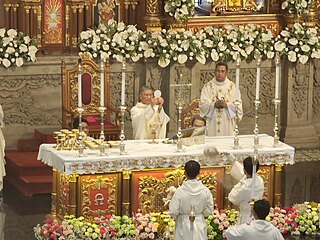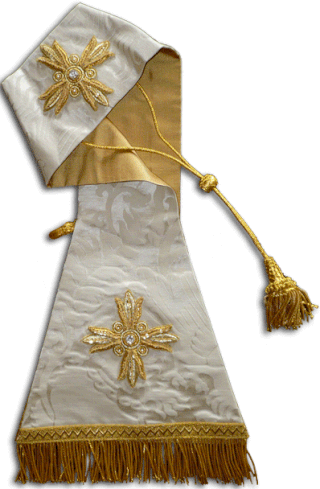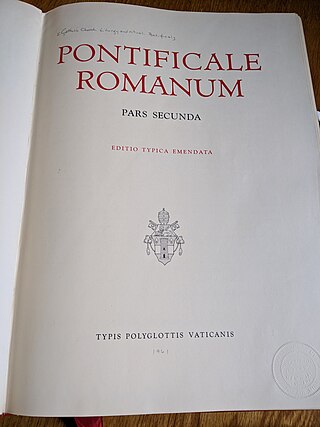
The Mass of Paul VI, also known as the Ordinary Form or Novus Ordo, is the most commonly used liturgy in the Catholic Church. It was promulgated by Pope Paul VI in 1969 and its liturgical books were published in 1970; those books were then revised in 1975, they were revised again by Pope John Paul II in 2000, and a third revision was published in 2002.

The Tridentine Mass, also known as the Traditional Latin Mass or the Traditional Rite, is the liturgy in the Roman Missal of the Catholic Church codified in 1570 and published thereafter with amendments up to 1962. Celebrated almost exclusively in Ecclesiastical Latin, it was the most widely used Eucharistic liturgy in the world from its issuance in 1570 until the introduction of the Mass of Paul VI.

An acolyte is an assistant or follower assisting the celebrant in a religious service or procession. In many Christian denominations, an acolyte is anyone performing ceremonial duties such as lighting altar candles. In others, the term is used for one who has been inducted into a particular liturgical ministry, even when not performing those duties.

The Ambrosian Rite is a Latin liturgical rite of the Catholic Church. The rite is named after Saint Ambrose, a bishop of Milan in the fourth century. It is used by around five million Catholics in the greater part of the Archdiocese of Milan, in some parishes of the Diocese of Como, Bergamo, Novara, Lodi, and in the Diocese of Lugano, Canton of Ticino, Switzerland.

A Pontifical High Mass, also called Solemn Pontifical Mass, is a Solemn or High Mass celebrated by a bishop using certain prescribed ceremonies. Although in modern English the word "pontifical" is almost exclusively associated with the pope, any bishop may be properly called a pontiff. Thus, the celebrant of a Pontifical High Mass may be the pope, any bishop or any other prelate who is allowed to wear pontificals.

The maniple is a liturgical vestment used primarily within the Latin Rite of the Catholic Church, and occasionally by some Anglo-Catholic and Lutheran clergy. It is an embroidered band of silk or like fabric that hangs from the left forearm, worn over the alb. It is used only during Mass, and it is always of the same liturgical colour as other Mass vestments.

The Use of Sarum is the liturgical use of the Latin rites developed at Salisbury Cathedral and used from the late eleventh century until the English Reformation. It is largely identical to the Roman Rite, with about ten per cent of its material drawn from other sources. The cathedral's liturgy was widely respected during the late Middle Ages, and churches throughout the British Isles and parts of northwestern Europe adapted its customs for celebrations of the Eucharist and canonical hours. The Sarum Rite has a unique ecumenical position in influencing and being authorized for liturgical use by the Roman Catholic Church, Eastern Orthodox Church, as well as the Anglican Communion.

The Roman Ritual, also known as Ritual is one of the official liturgical books of the Roman Rite of the Latin Church of the Catholic Church. It contains all of the services that a priest or deacon may perform; and are not contained in the Missale Romanum, Pontificale Romanum, or Caeremoniale Episcoporum, but for convenience does include some rituals that one of these books contains.

The Cæremoniale Episcoporum is a liturgical book that describes the church services to be performed by bishops of the Latin Church of the Catholic Church.

Latin liturgical rites, or Western liturgical rites, is a large family of liturgical rites and uses of public worship employed by the Latin Church, the largest particular church sui iuris of the Catholic Church, that originated in Europe where the Latin language once dominated. Its language is now known as Ecclesiastical Latin. The most used rite is the Roman Rite.

The Euchologion is one of the chief liturgical books of the Eastern Orthodox and Byzantine Catholic churches, containing the portions of the services which are said by the bishop, priest, or deacon. The Euchologion roughly corresponds to a combination of the missal, ritual, and pontifical as they are used in Latin liturgical rites. There are several different volumes of the book in use.

The Mass is the central liturgical service of the Eucharist in the Catholic Church, in which bread and wine are consecrated and become the body and blood of Christ. As defined by the Church at the Council of Trent, in the Mass "the same Christ who offered himself once in a bloody manner on the altar of the cross, is present and offered in an unbloody manner". The Church describes the Mass as the "source and summit of the Christian life", and teaches that the Mass is a sacrifice, in which the sacramental bread and wine, through consecration by an ordained priest, become the sacrificial body, blood, soul, and divinity of Christ as the sacrifice on Calvary made truly present once again on the altar. The Catholic Church permits only baptised members in the state of grace to receive Christ in the Eucharist.
Pontifical vestments, also referred to as episcopal vestments or pontificals, are the liturgical vestments worn by bishops in the Catholic, Eastern Orthodox, Oriental Orthodox, Anglican, and some Lutheran churches, in addition to the usual priestly vestments for the celebration of the mass, other sacraments, sacramentals, and canonical hours. The pontifical vestments are only worn when celebrating or presiding over liturgical functions. As such, the garments should not be confused with choir dress, which are worn when attending liturgical functions but not celebrating or presiding.

The Roman Pontifical is the pontifical as used in Roman Rite liturgies of the Catholic Church. It is the liturgical book that contains the rites and ceremonies usually performed by bishops.

A liturgical book, or service book, is a book published by the authority of a church body that contains the text and directions for the liturgy of its official religious services.

Within the Roman Rite of the Catholic Church, a variety of liturgical books have been officially approved to contain the words to be recited and the actions to be performed in the celebration of Catholic liturgy. The Roman Rite of the Latin Church of the Catholic Church is the most widely used liturgical rite. The titles of some of these books contain the adjective "Roman", e.g. the Roman Missal, to distinguish them from the liturgical books for the other rites of the church.
A use, also commonly usage and recension, within Christian liturgy is a set of particular texts or customs distinct from other practitioners of a broader liturgical ritual family, typically on the basis of locality or religious order. Especially prevalent within the Latin liturgical rites of the Middle Ages, few significant uses persisted following a general suppression of these variations by Pope Pius V in the 16th century. The word "use" is most commonly applied to distinct practices branching from the Roman Rite, though it and "recension" can be applied in variations of other ritual families, such as the to Ruthenian recension of the Byzantine Rite and Maronite Use of the West Syriac Rite. In the historic context of the Scottish Episcopal Church, "usage" refers to certain aspects of the Eucharistic liturgy valued by some nonjurors.
An ordinal, in a modern context, is a liturgical book that contains the rites and prayers for the ordination and consecration to the Holy Orders of deacons, priests, and bishops in multiple Christian denominations, especially the Edwardine Ordinals within Anglicanism. The term "ordinal" has been applied to the prayers and ceremonies for ordinations in the Catholic Church, where the pontificals of the Latin liturgical rites typically compile them along with other liturgies exclusive to bishops. In medieval liturgies, ordinals supplied instruction on how to use the various books necessary to celebrate a liturgy and added rubrical direction.

The Edwardine Ordinals are two ordinals primarily written by Thomas Cranmer as influenced by Martin Bucer and first published under Edward VI, the first in 1550 and the second in 1552, for the Church of England. Both liturgical books were intended to replace the ordination liturgies contained within medieval pontificals in use before the English Reformation.
The Eastern Catholic Churches of the Catholic Church utilize liturgies originating in Eastern Christianity, distinguishing them from the majority of Catholic liturgies which are celebrated according to the Latin liturgical rites of the Latin Church. While some of these sui iuris churches use the same liturgical ritual families as other Eastern Catholic churches and Eastern churches not in full communion with Rome, each church retains the right to institute its own canonical norms, liturgical books, and practices for the ritual celebration of the Eucharist, other sacraments, and canonical hours.

















